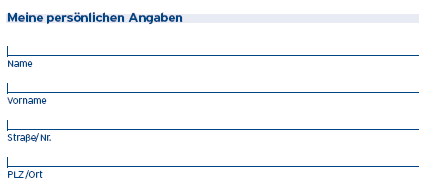Field positioning
Generally, position fields vertically so that they left-aligned. To avoid overwriting from one field into another the keep the vertical distance to a minimum of 3mm. Similarly, keep the horizontal distance to a minimum of 5mm.
Ideal field distances

Print labels and lead text with enough space so that hand printed information can exceed the field boundaries without overlapping them. Do not print leading text inside a field.
It is recommended to group fields by subject and to label and mark them together. For example, group address fields with a frame and a title that makes it clear that these fields are meant to be used together.
Grouped address fields

- Recommendations
-
-
Minimum vertical distance of 3mm
-
Minimum horizontal distance of 5mm
-
Group fields when appropriate
-